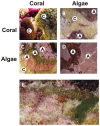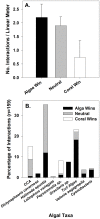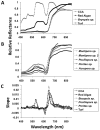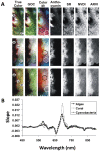Hyperspectral and physiological analyses of coral-algal interactions
- PMID: 19956632
- PMCID: PMC2778555
- DOI: 10.1371/journal.pone.0008043
Hyperspectral and physiological analyses of coral-algal interactions
Abstract
Space limitation leads to competition between benthic, sessile organisms on coral reefs. As a primary example, reef-building corals are in direct contact with each other and many different species and functional groups of algae. Here we characterize interactions between three coral genera and three algal functional groups using a combination of hyperspectral imaging and oxygen microprofiling. We also performed in situ interaction transects to quantify the relative occurrence of these interaction on coral reefs. These studies were conducted in the Southern Line Islands, home to some of the most remote and near-pristine reefs in the world. Our goal was to determine if different types of coral-coral and coral-algal interactions were characterized by unique fine-scale physiological signatures. This is the first report using hyperspectral imaging for characterization of marine benthic organisms at the micron scale and proved to be a valuable tool for discriminating among different photosynthetic organisms. Consistent patterns emerged in physiology across different types of competitive interactions. In cases where corals were in direct contact with turf or macroalgae, there was a zone of hypoxia and altered pigmentation on the coral. In contrast, interaction zones between corals and crustose coralline algae (CCA) were not hypoxic and the coral tissue was consistent across the colony. Our results suggest that at least two main characteristic coral interaction phenotypes exist: 1) hypoxia and coral tissue disruption, seen with interactions between corals and fleshy turf and/or some species of macroalgae, and 2) no hypoxia or tissue disruption, seen with interactions between corals and some species of CCA. Hyperspectral imaging in combination with oxygen profiling provided useful information on competitive interactions between benthic reef organisms, and demonstrated that some turf and fleshy macroalgae can be a constant source of stress for corals, while CCA are not.
Conflict of interest statement
Figures





Similar articles
-
Microbial to reef scale interactions between the reef-building coral Montastraea annularis and benthic algae.Proc Biol Sci. 2012 Apr 22;279(1733):1655-64. doi: 10.1098/rspb.2011.2155. Epub 2011 Nov 16. Proc Biol Sci. 2012. PMID: 22090385 Free PMC article.
-
Evidence for water-mediated mechanisms in coral-algal interactions.Proc Biol Sci. 2016 Aug 17;283(1836):20161137. doi: 10.1098/rspb.2016.1137. Proc Biol Sci. 2016. PMID: 27512146 Free PMC article.
-
Coral-algal interactions at Weizhou Island in the northern South China Sea: variations by taxa and the exacerbating impact of sediments trapped in turf algae.PeerJ. 2019 Mar 13;7:e6590. doi: 10.7717/peerj.6590. eCollection 2019. PeerJ. 2019. PMID: 30886777 Free PMC article.
-
Unseen players shape benthic competition on coral reefs.Trends Microbiol. 2012 Dec;20(12):621-8. doi: 10.1016/j.tim.2012.08.004. Epub 2012 Sep 1. Trends Microbiol. 2012. PMID: 22944243 Review.
-
Biological and remote sensing perspectives of pigmentation in coral reef organisms.Adv Mar Biol. 2002;43:277-317. doi: 10.1016/s0065-2881(02)43006-4. Adv Mar Biol. 2002. PMID: 12154614 Review.
Cited by
-
Macroalgae decrease growth and alter microbial community structure of the reef-building coral, Porites astreoides.PLoS One. 2012;7(9):e44246. doi: 10.1371/journal.pone.0044246. Epub 2012 Sep 5. PLoS One. 2012. PMID: 22957055 Free PMC article.
-
Responses of Herbivorous Fishes and Benthos to 6 Years of Protection at the Kahekili Herbivore Fisheries Management Area, Maui.PLoS One. 2016 Jul 27;11(7):e0159100. doi: 10.1371/journal.pone.0159100. eCollection 2016. PLoS One. 2016. PMID: 27462981 Free PMC article.
-
Microbial to reef scale interactions between the reef-building coral Montastraea annularis and benthic algae.Proc Biol Sci. 2012 Apr 22;279(1733):1655-64. doi: 10.1098/rspb.2011.2155. Epub 2011 Nov 16. Proc Biol Sci. 2012. PMID: 22090385 Free PMC article.
-
In-Situ Effects of Simulated Overfishing and Eutrophication on Benthic Coral Reef Algae Growth, Succession, and Composition in the Central Red Sea.PLoS One. 2013 Jun 19;8(6):e66992. doi: 10.1371/journal.pone.0066992. Print 2013. PLoS One. 2013. PMID: 23840570 Free PMC article.
-
Investigating functional redundancy versus complementarity in Hawaiian herbivorous coral reef fishes.Oecologia. 2016 Dec;182(4):1151-1163. doi: 10.1007/s00442-016-3724-0. Epub 2016 Sep 20. Oecologia. 2016. PMID: 27651229
References
-
- Wilkinson C. Townsville: Australian Institute of Marine Science; 2004. Status of coral reefs of the world: 2004. p. 547 p.
-
- Hoegh-Guldberg O, Mumby PJ, Hooten AJ, Steneck RS, Greenfield P, et al. Coral reefs under rapid climate change and ocean acidification. Science. 2007;318:1737–1742. - PubMed
-
- Hughes TP, Baird AH, Bellwood DR, Card M, Connolly SR, et al. Climate change, human impacts, and the resilience of coral reefs. Science. 2003;301:929–933. - PubMed
-
- Hoegh-Guldberg O, Australia G. Climate change, coral bleaching and the future of the world's coral reefs. Mar Freshwat Res. 1999;50:839–866.
-
- Harvell CD, Kim K, Burkholder JM, Colwell RR, Epstein PR, et al. Emerging marine diseases - climate links and anthropogenic factors. Science. 1999;285:1505–1510. - PubMed
Publication types
MeSH terms
Substances
LinkOut - more resources
Full Text Sources
Research Materials

